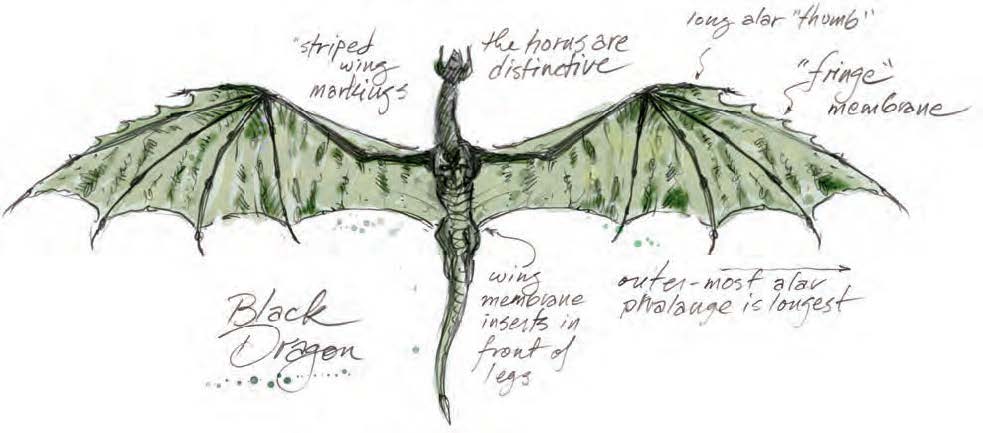Black Dragon
Black dragons are among the most evil-tempered true dragons. They prefer dismal swamps or bogs, the more stagnant and fetid the better, but can be encountered anywhere water and dense vegetation are found together— including jungles, rain forests, and moors. They have no natural enemies, though they attack and kill almost anything unfortunate enough to stumble upon them. Black dragons living in forest areas often encounter green dragons, but the two species usually manage to maintain an uneasy truce, so long as the black dragons stick to the watery areas.
Black dragons make their lairs in large, damp caves or multichambered submerged caverns. They always dwell near water, and their lairs usually have a submerged entrance and a land entrance. Older black dragons hide both entrances to their lairs with plant growth.
Black dragons dwelling in dungeons prefer dark, watery locations.
Black Dragon Identifiers
A black dragon has deep-socketed eyes and broad nasal openings hat make its face look like a skull. It has segmented horns that curve forward and down, somewhat like a ram’s horns, but not as curly. These horns are bone-colored near their bases, but darken to dead black at the tips. As the dragon ages, the flesh around the horns and cheekbones deteriorates, as though eaten by acid, leaving only thin layers of hide covering the skull. This phenomenon is not harmful to the dragon, but enhances its skeletal appearance. Most of a black dragon’s teeth protrude when the mouth is closed, and big spikes stud the lower jaw. A pair of small horns jut from the chin, and a row of hornlets crown the head. The tongue is flat, with a forked tip, and the dragon often drools acidic slime. A black dragon smells of rotting vegetation and foul water, with an acidic undertone. A black dragon flying overhead is marked by a distinctive profile. Its horns, with their characteristic forward curve, are clearly visible. The wing membranes are marked with blobby stripes, and the leading edges of the wings are fringed or scalloped near the tips. A black dragon also has exceptionally long alar thumbs. The trailing edges of the wing membranes join the body ahead of the back legs. On hatching, a black dragon’s scales are thin, small, and glossy. As the dragon ages, they become larger, thicker, and duller, helping it camouflage itself in swamps and marshes.Habits
Black dragons dine primarily on fish, mollusks, and other aquatic creatures. They also hunt for red meat but like to “pickle” it by letting it lie in ponds within or near their lairs for days before being eaten. The rotting flesh helps make the area even more foul—just the way the dragon likes it. Black dragons are especially fond of coins. Older and craftier dragons sometimes capture and question humanoids about stockpiles of gold, silver, and platinum coins before killing them. Others move out into nearby rivers or lakes, where they menace boat traffic and demand that passing vessels pay tribute. In keeping with their reputation for ferocity, black dragons usually fight for their mates. The females do most of the fighting, flying far and wide to locate a desirable male and then impressing him with a victory over a rival. Eggs are usually laid near the male’s lair, and the male is left to guard the young. Black dragon parents are protective, but give their offspring little support beyond the occasional bit of advice. Eventually, the parent advises its offspring to leave the area before the older dragon decides to eat the youngster. Although capable of breathing underwater, black dragons do little actual swimming; instead, they wallow in the shallows, enjoying the feel of the mud or simply lying in wait for prey. Black dragons prefer to ambush their targets, using their surroundings as cover. When fighting in heavily forested swamps and marshes, they try to stay in the water or on the ground; trees and leafy canopies limit their aerial maneuverability. When outmatched, a black dragon attempts to fly out of sight, so as not to leave tracks, and takes refuge in the deepest water it can find.Sources:
- Dungeons & Dragons Draconomicon (3.5 Edition, 2009).
- Monster Manual, Black Dragon
Related Ethnicities




Comments